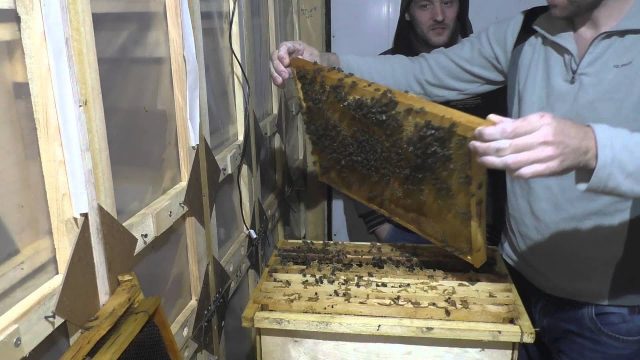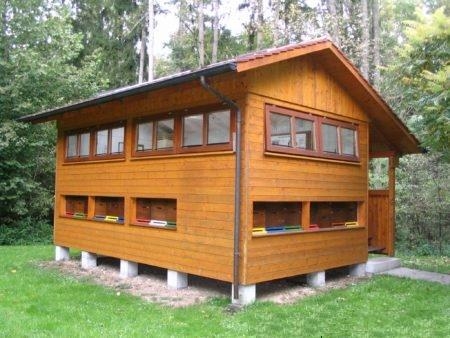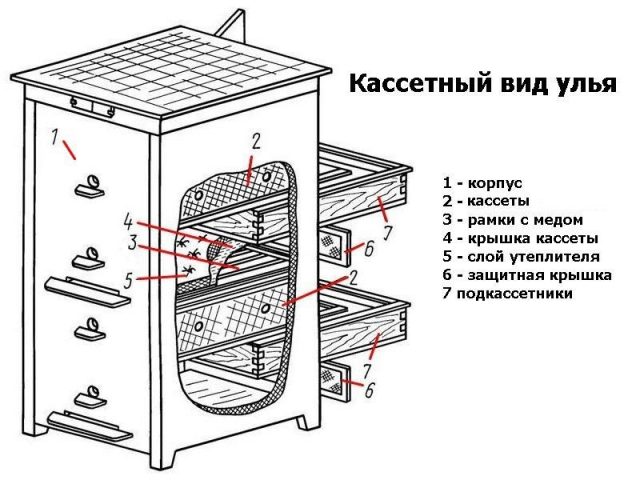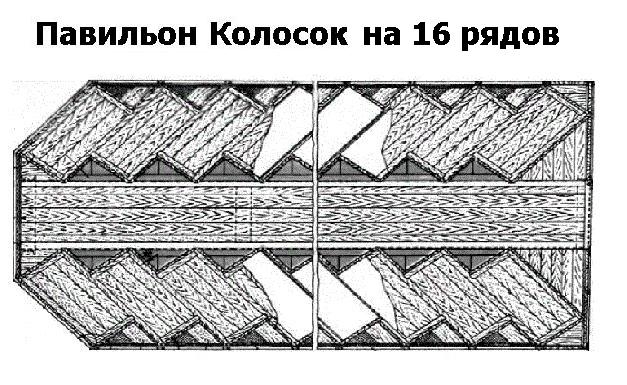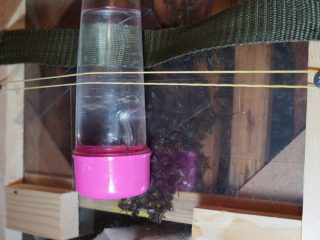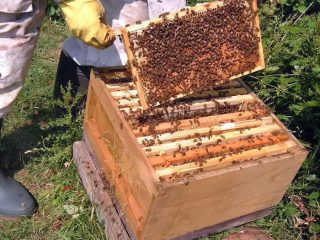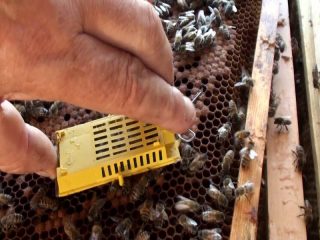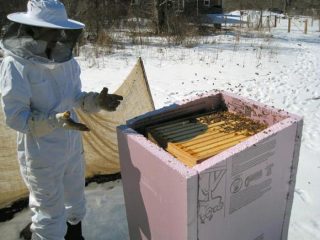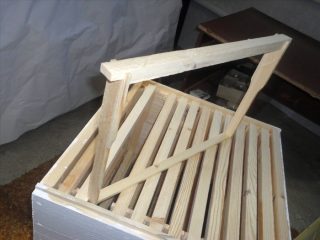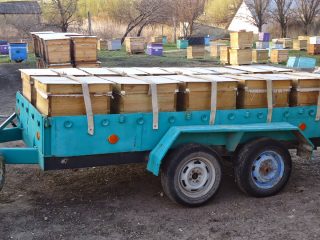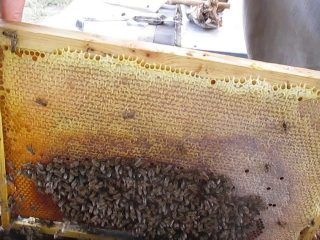Content
The bee pavilion simplifies the insect care process. The mobile structure is effective for keeping a nomadic apiary. A stationary pavilion helps to save space on the site, increases the survival rate of bees during wintering.
Benefits of pavilion beekeeping
The first pavilions appeared in European countries. In Russia, the technology began to develop later, and gained popularity in the Urals and the North Caucasus. Pavilion beekeeping is different from the traditional method. Bee hives are replaced by special cassette modules. Insects live in their houses all year round. Bees fly out into the street through the entrances. In order for the returning insects to easily find their entrance, beekeepers mark each entrance hole with colorful figurines.
The popularity of pavilion content is due to a number of advantages:
- Good mobility of the mobile pavilion during the wandering.
- Ease of maintenance. During the move, the hives must be constantly loaded and unloaded from the vehicle's trailer. It is enough to move the pavilion to another location.
- The pavilion always maintains optimal conditions for the withdrawal of the uterus. In hives, this is not possible. The process will depend on weather conditions.
- The presence of a mobile house contributes to an increase in honey collection.
- An optimal microclimate for bees is created inside the pavilion. Insects hibernate and develop better.
- Bee colonies living in one large pavilion pose less danger to humans and animals than insects, whose hives are scattered over a large area.
A stationary and mobile pavilion is, first of all, compactness. A large number of bee colonies can be kept in a small area.
Types of beekeeping pavilions
If we talk about the fundamental differences between the pavilions, there are only two of them. Structures are mobile and stationary. Minor differences are in size, design and other insignificant trifles.
Stationary pavilion for bees
The exterior of the stationary pavilion resembles a wooden utility block. The house is installed on a strip or columnar foundation. The stationary pavilion has several advantages over the mobile analogue:
- lighting, plumbing, sewerage can be brought into the house;
- for heating in winter, heating is supplied to the pavilion.
In fact, a stationary house is a complete residential complex for bees. The supply of communications facilitates the process of maintaining the apiary. Heating makes wintering safe. The bees do not weaken, and those that have become stronger begin to work more intensively in the spring.
Stationary pavilions are convenient for wintering bees even without heating. There is enough natural warmth inside the house. They try to arrange a stationary building on the site so that the long side wall faces southwest or southeast.
A roof for a stationary structure is made of two types. A less successful option is considered a gable without opening hatches.Windows are provided on the walls, but in order to open them, free space must be left for access. The best option is a flat roof with opening hatches. Inside such a building, space is saved, since the cassettes with bees can be placed close to the wall.
Cassette (mobile) pavilion for bees
The basic structure of a mobile pavilion is no different from a stationary bee house. The same wooden building with a flat or gable roof. The main difference is the lower part. If the foundation is poured for a stationary house, then the mobile structure is placed on the chassis.
Typically, the chassis is a trailer of a truck or agricultural machinery. During construction, it is lifted with a jack and placed horizontally on supports. The sides of the trailer are removed, leaving only the frame. It will serve as the foundation. By the size of the frame, the metal frame of the future house is welded. Sheathing is performed with chipboard, boards or other material.
For stationary use, the building can stand on props. With the beginning of the season, the structure is raised with jacks. The supports are removed from under the trailer. The pavilion with bees is hooked to the car, taken to the field closer to the honey plants.
The cassette mobile design has many advantages:
- Increase in the bribe due to the approach of the apiary directly to the seasonal flowering honey plants. The honey yield doubles. Overcoming a shorter distance, the bees bring 100% of the collected product into the combs.
- The beekeeper is given the opportunity to get pure honey from one sort of honey plant. Bees will only carry the product from close growing flowers. During the season, with frequent moves, you can get several varieties of pure honey, for example: acacia, sunflower, buckwheat.
- The ease of maintenance of a mobile pavilion is the same as for a stationary structure. For the winter, bees stay in their houses.
The only disadvantage of the mobile pavilion is the impossibility of supplying communications. However, plumbing and sewerage are not as important to the bees. Comfort elements are in demand by the beekeeper. As for lighting and heating, wiring is needed. During the winter, the house stands in the yard. The cable is connected to the home power supply. Light appears inside the pavilion. Heating for bees is organized from electric heaters.
How to make a cassette pavilion for bees with your own hands
The construction of the pavilion itself is no different from the construction of an ordinary barn. In general terms: first, they prepare the base (foundation or trailer on wheels), create a frame, sheathe, equip the roof, windows, doors. Initially, you will need to think about the layout. If you make a pavilion for bees with your own hands mobile, then you need to correctly position the change house.
To accommodate a lot of bee colonies, a standard size trailer for a large house is not enough. The frame is lengthened, which increases the load on the rear axle. For its even distribution, the change house is located in front of the hitch with the car. It is optimal to make a drawing before starting construction, think over all the nuances, calculate the consumption of materials.
Drawings of pavilions for bees
The interior of the large pavilion is divided by partitions. 5-12 cassette modules are vertically installed in each compartment. They must be the same size. Cassette modules are often made for frames of 450x300 mm. It is advisable to install no more than 60 cassette hives inside.
The cassette module or hive consists of a body. Cassettes with frames are inserted inside. They are closed with protective covers. The cassettes are supported on cassettes.
Convenient for the year-round keeping of bees is the Spikelet pavilion, which contains 16 rows of cassette modules.They are installed at an angle of 50 to the aisle. about... The spikelet is always placed in front on the south side. Then the cassette modules of the rows will be deployed to the southwest and southeast.
Required tools and materials
From the materials for the base of the mobile structure, you will need a trailer. The foundation of a stationary building is poured from concrete, pillars are laid out of blocks or screw piles are screwed in. The frame of a mobile house is welded from a profile or pipe, and a stationary pavilion is assembled from a bar. For cladding, a board or wood-based panels is the best material. The roof is made of lightweight roofing materials.
For work, you will need woodworking and construction tools:
- hacksaw;
- Bulgarian;
- electric drill;
- hammer;
- jigsaw;
- welding machine.
It is impossible to list the entire list of tools. It will depend on the type of construction and the materials used.
Construction of a pavilion for bees
In general terms, the construction process consists of the following points:
- Registration. In terms of size, the building is erected with a maximum of 20 compartments for the installation of cassette modules. With a larger number of bees will push each other. For a stationary building, they initially choose the most convenient place away from people and the mass keeping of animals. After assembling the frame of the house, it is optimal to start manufacturing and installing cassette modules. They are connected to each other and only then a common roof is erected.
- Compartments. The inventory compartment and the change house in a stationary building are at their discretion. On the mobile pavilion, they are provided in front of the trailer near the hitch with the car. The compartments for keeping bees in the modules are located in one or opposite directions. The Spikelet scheme is considered more convenient.
- Lighting. Natural light through the windows will not be enough for bees and the attendant beekeeper. Wiring is laid inside the house, lights are connected.
- Change house. The design of the beekeeper's closet provides for the installation of cabinets for storing clothes, feeding for bees, and working equipment. In the case of a mobile apiary, an overnight stay is provided.
- Thermal insulation. For optimal wintering of bees, all structural elements must be insulated. If the walls are made of planks, no additional insulation is needed. When using plywood, double sheathing of the frame is made. The void is filled with insulation, for example, mineral wool. More attention is paid to the insulation of windows, doors, ceilings, since it is in these places that large heat losses are observed.
The roof is made strong but lightweight. No extra load is needed, especially if the apiary is of a mobile type.
More details about the pavilion for keeping bees are described in the video:
Ventilation in the bee pavilion
Natural ventilation from spring to autumn is provided by ventilation through windows and doors. In winter, a lot of moisture collects inside and around the cassette modules. Humidity rises strongly in stationary houses on strip foundations. Based on reasonable considerations, it is better to install non-mobile buildings on columnar or pile foundations. Additionally, supply and exhaust channels are equipped with adjustable dampers. Natural ventilation is arranged so that in winter, along with the musty air, moisture leaves, and heat is retained in the modules.
Rules for keeping bees in pavilions
The first important rule of keeping bees is to have high-quality heating and ventilation inside the pavilion. In winter, the inspection method is used to reveal the pore. If a good microclimate is maintained inside the pavilion, bees practically do not die. Top dressing is carried out through the feeders. They are attached to the doors of the cassette modules. The amount of feed is checked by inspection through the transparent wall of the trough. In February, Kandy is used for feeding. To prevent the food from drying out, cover it with foil on top.
Conclusion
The bee pavilion initially requires manufacturing costs. In the future, the maintenance of bees will be simplified, the beekeeper receives more honey, insects endure the winter more easily, and the amount of death will decrease.
